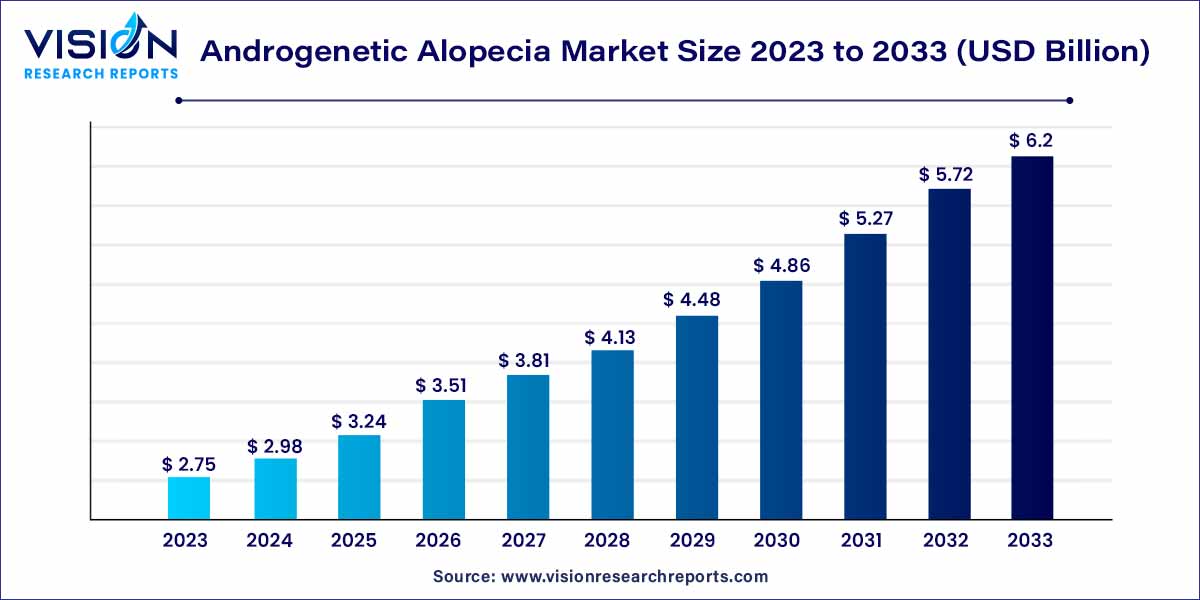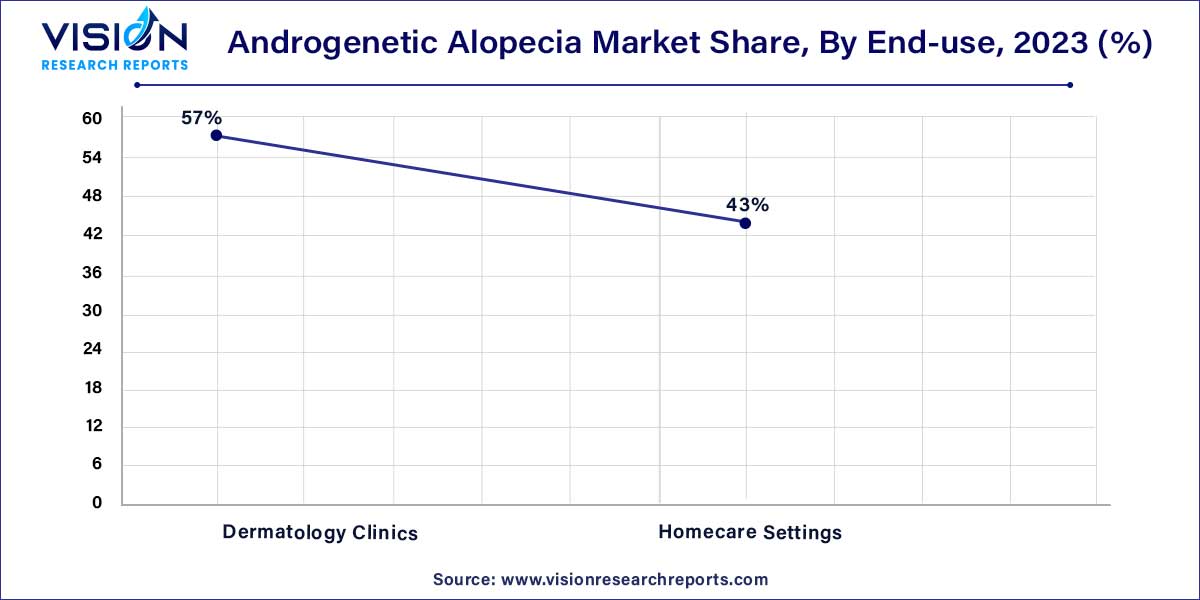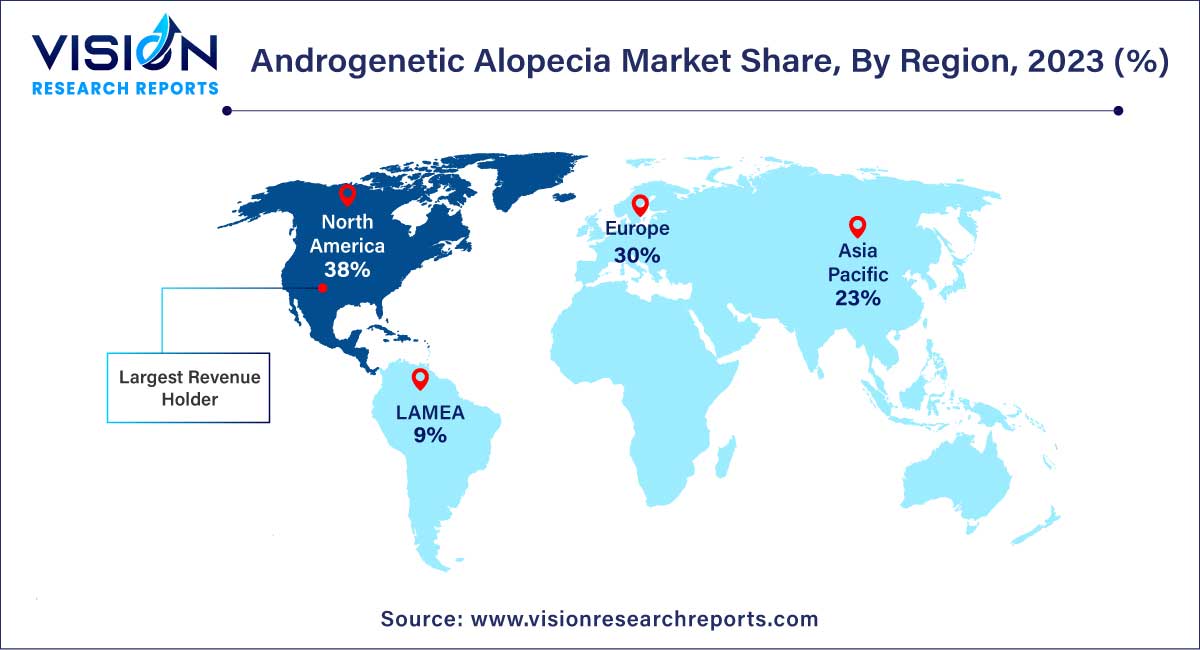The global androgenetic alopecia market size was estimated at around USD 2.75 billion in 2023 and it is projected to hit around USD 6.2 billion by 2033, growing at a CAGR of 8.47% from 2024 to 2033. The androgenetic alopecia market is driven by an increasing demand for therapeutics due to the rising incidence of androgenic alopecia (AGA) globally.

Androgenetic alopecia, commonly known as male or female pattern baldness, is a prevalent form of hair loss affecting millions of individuals worldwide. This condition is characterized by the gradual thinning and loss of hair, typically following a specific pattern on the scalp. The androgenetic alopecia market encompasses various products and treatment options aimed at managing and potentially reversing hair loss, catering to the diverse needs of affected individuals.
The growth of the androgenetic alopecia market is propelled by several key factors. Firstly, the increasing prevalence of hair loss disorders, fueled by factors such as changing lifestyle patterns, genetic predisposition, and hormonal imbalances, contributes significantly to market growth. Additionally, rising awareness among individuals about available treatment options and advancements in medical technology drive the adoption of products and procedures aimed at managing and potentially reversing hair loss. Furthermore, the growing demand for cosmetic solutions to enhance physical appearance and improve self-esteem further boosts market expansion.
The male segment accounted for the largest share of 57% in 2023. Increasing prevalence is estimated to accelerate segment growth during the forecast period. For instance, according to data published by the American Hair Loss Association and the U.S. National Library of Medicine, over 95% of hair loss cases among men are androgenetic type, and about 50% of men tend to experience some degree of hair loss at an average age of 50 years. In addition, rising investments by pharmaceutical companies to develop new products are projected to impact segment growth positively.
The increasing incidence of diseases associated with AA, such as PCOS, rise in cosmetic procedures, and lifestyle changes are driving the segment's growth. Furthermore, rising awareness among women highlights segment growth. Various treatment options aim to address this condition, including topical minoxidil, an FDA-approved over-the-counter solution. Oral medications, such as finasteride, may be prescribed, although it is not FDA-approved for women of childbearing age. Low-level laser therapy and platelet-rich plasma injections are emerging as noninvasive alternatives.
The pharmaceuticals segment accounted for the largest revenue share of 99% in 2023. Increasing product availability in the market positively impacts segment growth. Several prescription treatments, including minoxidil, betamethasone dipropionate, and fluocinolone acetonide, are available in the market for hair regrowth in androgenetic alopecia patients. In addition, an increasing number of clinical trials and product development activities are expected to boost segment growth. For instance, in March 2023, OliX Pharmaceuticals received approval from authorities to initiate its phase 1 clinical trial for the treatment of androgenetic alopecia. The company would investigate its candidate OLX72021 for its efficacy over androgenetic alopecia.
The devices segment is expected to register the fastest CAGR from 2024 to 2033. Increasing familiarity of the global population with technology is improving the adoption rate of devices for the treatment of androgenetic alopecia. In addition, devices based on low-level laser therapy (LLLT) offer the convenience of at-home use and minimize the need for clinical visits. Moreover, it provides a non-pharmacological and nonsurgical viable therapeutic action for hair restoration, due to which the market is expected to grow steadily. In addition, technological advancements are projected to offer lucrative growth opportunities in the segment. For instance, in October 2022, a group of researchers from the National Natural Science Foundation of China discovered a new design of microneedle patches for the treatment of AA with the help of AI.
The dermatology clinics segment held the largest revenue share of 57% in 2023. The large share is attributed to increased consumer awareness regarding prescription medicines & modern treatments, such as laser technology, coupled with a strong product pipeline. Advanced treatment therapies and devices combined with novel haircare products help overcome hair loss problems. In April 2020, Bimini Health Tech announced topline results for the phase 2 clinical trial on Kerastem in the U.S. The single procedure therapy consists of doses of Adipose-derived Regenerative Cells (ADRCs) combined with Puregraft purified fat, depending on the severity of hair loss.

The homecare settings segment is projected to witness the highest CAGR from 2024 to 2033. Technological advancements have led to the introduction of novel devices for the treatment of androgenetic alopecia that can be used in home care settings. Patient comfort, convenience, and ease of use are considered for developing homecare devices. Companies are focusing on developing low-cost, home-grade lasers for home use, such as laser caps, helmets, laser combs, and other systems. In March 2020, LifeMD received U.S. FDA approval for its proprietary laser-based product, the Shapiro MD hair restoration device.
The prescription segment generated the maximum market share of 66% in 2023, driven by a strong product pipeline, growing disposable income, and rising adoption of unhealthy lifestyles, resulting in chronic diseases, such as cancer, PCOS, & diabetes, which can cause AGA. Moreover, a growing number of research and development activities are likely to boost the discovery of new molecules, which will eventually positively impact segment growth. For instance, in June 2022, a group of researchers from the University of California announced the discovery of a new hair stimulator, SCUBE3. This signaling molecule shows promise as a therapeutic solution for AA, a prevalent form of hair loss affecting both men and women. The discovery opens avenues for potential treatments targeting this molecular pathway.
The over-the-counter segment is expected to witness substantial growth. Patent expiries of the key FDA-approved therapeutics, such as Avodart (dutasteride), Rogaine (minoxidil), and Propecia (finasteride), led to large-scale penetration of generics into this market. Furthermore, the lack of approved drugs has driven the usage of several products, including OTC or off-label drugs. The increasing demand for affordable hair loss treatments, increased consumer awareness regarding the potential side effects of prescribed drugs, and growing accessibility of over-the-counter (OTC) medications are key factors driving the market. OTC products are particularly prevalent in developing regions, presenting multiple opportunities for industry players to address unmet medical needs through product reformulation.
North America dominated the market and accounted for a share of 38% in 2023. Growth in the region is driven by a high disease prevalence, rising consumer awareness, proactive government measures, technological advancements, and improvements in healthcare infrastructure. Moreover, the presence of major companies involved in developing treatments for AGA, such as Concert Pharmaceuticals, Inc.; Eli Lilly & Company; RepliCel Life Sciences; & Triple Hair, is anticipated to drive market growth. In addition, the presence of non-invasive therapies with minimal side effects, such as laser therapy, is anticipated to improve the treatment rate in North America.

Androgenetic alopecia market in Asia Pacific is anticipated to witness significant growth from 2024 to 2033. Increasing awareness is a major factor driving the market growth in this region. The local presence of key players, such as Cipla, Dr. Reddy’s Laboratories Ltd, & Aurobindo Pharma, is expected to drive overall market growth. Increasing avenues of scientific research, untapped opportunities in the form of unmet medical needs, and economic growth are expected to be additional growth drivers.
Androgenetic Alopecia Market Segmentations:
By Gender
By Treatment
By End-use
By Sales Channel
By Region
Chapter 1. Introduction
1.1. Research Objective
1.2. Scope of the Study
1.3. Definition
Chapter 2. Research Methodology
2.1. Research Approach
2.2. Data Sources
2.3. Assumptions & Limitations
Chapter 3. Executive Summary
3.1. Market Snapshot
Chapter 4. Market Variables and Scope
4.1. Introduction
4.2. Market Classification and Scope
4.3. Industry Value Chain Analysis
4.3.1. Raw Material Procurement Analysis
4.3.2. Sales and Distribution Channel Analysis
4.3.3. Downstream Buyer Analysis
Chapter 5. COVID 19 Impact on Androgenetic Alopecia Market
5.1. COVID-19 Landscape: Androgenetic Alopecia Industry Impact
5.2. COVID 19 - Impact Assessment for the Industry
5.3. COVID 19 Impact: Global Major Government Policy
5.4. Market Trends and Opportunities in the COVID-19 Landscape
Chapter 6. Market Dynamics Analysis and Trends
6.1. Market Dynamics
6.1.1. Market Drivers
6.1.2. Market Restraints
6.1.3. Market Opportunities
6.2. Porter’s Five Forces Analysis
6.2.1. Bargaining power of suppliers
6.2.2. Bargaining power of buyers
6.2.3. Threat of substitute
6.2.4. Threat of new entrants
6.2.5. Degree of competition
Chapter 7. Competitive Landscape
7.1.1. Company Market Share/Positioning Analysis
7.1.2. Key Strategies Adopted by Players
7.1.3. Vendor Landscape
7.1.3.1. List of Suppliers
7.1.3.2. List of Buyers
Chapter 8. Global Androgenetic Alopecia Market, By Gender
8.1. Androgenetic Alopecia Market, by Gender, 2024-2033
8.1.1. Male
8.1.1.1. Market Revenue and Forecast (2021-2033)
8.1.2. Female
8.1.2.1. Market Revenue and Forecast (2021-2033)
Chapter 9. Global Androgenetic Alopecia Market, By Treatment
9.1. Androgenetic Alopecia Market, by Treatment, 2024-2033
9.1.1. Pharmaceuticals
9.1.1.1. Market Revenue and Forecast (2021-2033)
9.1.2. Devices
9.1.2.1. Market Revenue and Forecast (2021-2033)
Chapter 10. Global Androgenetic Alopecia Market, By End-use
10.1. Androgenetic Alopecia Market, by End-use, 2024-2033
10.1.1. Dermatology Clinics
10.1.1.1. Market Revenue and Forecast (2021-2033)
10.1.2. Homecare Settings
10.1.2.1. Market Revenue and Forecast (2021-2033)
Chapter 11. Global Androgenetic Alopecia Market, By Sales Channel
11.1. Androgenetic Alopecia Market, by Sales Channel, 2024-2033
11.1.1. Prescriptions
11.1.1.1. Market Revenue and Forecast (2021-2033)
11.1.2. OTC
11.1.2.1. Market Revenue and Forecast (2021-2033)
Chapter 12. Global Androgenetic Alopecia Market, Regional Estimates and Trend Forecast
12.1. North America
12.1.1. Market Revenue and Forecast, by Gender (2021-2033)
12.1.2. Market Revenue and Forecast, by Treatment (2021-2033)
12.1.3. Market Revenue and Forecast, by End-use (2021-2033)
12.1.4. Market Revenue and Forecast, by Sales Channel (2021-2033)
12.1.5. U.S.
12.1.5.1. Market Revenue and Forecast, by Gender (2021-2033)
12.1.5.2. Market Revenue and Forecast, by Treatment (2021-2033)
12.1.5.3. Market Revenue and Forecast, by End-use (2021-2033)
12.1.5.4. Market Revenue and Forecast, by Sales Channel (2021-2033)
12.1.6. Rest of North America
12.1.6.1. Market Revenue and Forecast, by Gender (2021-2033)
12.1.6.2. Market Revenue and Forecast, by Treatment (2021-2033)
12.1.6.3. Market Revenue and Forecast, by End-use (2021-2033)
12.1.6.4. Market Revenue and Forecast, by Sales Channel (2021-2033)
12.2. Europe
12.2.1. Market Revenue and Forecast, by Gender (2021-2033)
12.2.2. Market Revenue and Forecast, by Treatment (2021-2033)
12.2.3. Market Revenue and Forecast, by End-use (2021-2033)
12.2.4. Market Revenue and Forecast, by Sales Channel (2021-2033)
12.2.5. UK
12.2.5.1. Market Revenue and Forecast, by Gender (2021-2033)
12.2.5.2. Market Revenue and Forecast, by Treatment (2021-2033)
12.2.5.3. Market Revenue and Forecast, by End-use (2021-2033)
12.2.5.4. Market Revenue and Forecast, by Sales Channel (2021-2033)
12.2.6. Germany
12.2.6.1. Market Revenue and Forecast, by Gender (2021-2033)
12.2.6.2. Market Revenue and Forecast, by Treatment (2021-2033)
12.2.6.3. Market Revenue and Forecast, by End-use (2021-2033)
12.2.6.4. Market Revenue and Forecast, by Sales Channel (2021-2033)
12.2.7. France
12.2.7.1. Market Revenue and Forecast, by Gender (2021-2033)
12.2.7.2. Market Revenue and Forecast, by Treatment (2021-2033)
12.2.7.3. Market Revenue and Forecast, by End-use (2021-2033)
12.2.7.4. Market Revenue and Forecast, by Sales Channel (2021-2033)
12.2.8. Rest of Europe
12.2.8.1. Market Revenue and Forecast, by Gender (2021-2033)
12.2.8.2. Market Revenue and Forecast, by Treatment (2021-2033)
12.2.8.3. Market Revenue and Forecast, by End-use (2021-2033)
12.2.8.4. Market Revenue and Forecast, by Sales Channel (2021-2033)
12.3. APAC
12.3.1. Market Revenue and Forecast, by Gender (2021-2033)
12.3.2. Market Revenue and Forecast, by Treatment (2021-2033)
12.3.3. Market Revenue and Forecast, by End-use (2021-2033)
12.3.4. Market Revenue and Forecast, by Sales Channel (2021-2033)
12.3.5. India
12.3.5.1. Market Revenue and Forecast, by Gender (2021-2033)
12.3.5.2. Market Revenue and Forecast, by Treatment (2021-2033)
12.3.5.3. Market Revenue and Forecast, by End-use (2021-2033)
12.3.5.4. Market Revenue and Forecast, by Sales Channel (2021-2033)
12.3.6. China
12.3.6.1. Market Revenue and Forecast, by Gender (2021-2033)
12.3.6.2. Market Revenue and Forecast, by Treatment (2021-2033)
12.3.6.3. Market Revenue and Forecast, by End-use (2021-2033)
12.3.6.4. Market Revenue and Forecast, by Sales Channel (2021-2033)
12.3.7. Japan
12.3.7.1. Market Revenue and Forecast, by Gender (2021-2033)
12.3.7.2. Market Revenue and Forecast, by Treatment (2021-2033)
12.3.7.3. Market Revenue and Forecast, by End-use (2021-2033)
12.3.7.4. Market Revenue and Forecast, by Sales Channel (2021-2033)
12.3.8. Rest of APAC
12.3.8.1. Market Revenue and Forecast, by Gender (2021-2033)
12.3.8.2. Market Revenue and Forecast, by Treatment (2021-2033)
12.3.8.3. Market Revenue and Forecast, by End-use (2021-2033)
12.3.8.4. Market Revenue and Forecast, by Sales Channel (2021-2033)
12.4. MEA
12.4.1. Market Revenue and Forecast, by Gender (2021-2033)
12.4.2. Market Revenue and Forecast, by Treatment (2021-2033)
12.4.3. Market Revenue and Forecast, by End-use (2021-2033)
12.4.4. Market Revenue and Forecast, by Sales Channel (2021-2033)
12.4.5. GCC
12.4.5.1. Market Revenue and Forecast, by Gender (2021-2033)
12.4.5.2. Market Revenue and Forecast, by Treatment (2021-2033)
12.4.5.3. Market Revenue and Forecast, by End-use (2021-2033)
12.4.5.4. Market Revenue and Forecast, by Sales Channel (2021-2033)
12.4.6. North Africa
12.4.6.1. Market Revenue and Forecast, by Gender (2021-2033)
12.4.6.2. Market Revenue and Forecast, by Treatment (2021-2033)
12.4.6.3. Market Revenue and Forecast, by End-use (2021-2033)
12.4.6.4. Market Revenue and Forecast, by Sales Channel (2021-2033)
12.4.7. South Africa
12.4.7.1. Market Revenue and Forecast, by Gender (2021-2033)
12.4.7.2. Market Revenue and Forecast, by Treatment (2021-2033)
12.4.7.3. Market Revenue and Forecast, by End-use (2021-2033)
12.4.7.4. Market Revenue and Forecast, by Sales Channel (2021-2033)
12.4.8. Rest of MEA
12.4.8.1. Market Revenue and Forecast, by Gender (2021-2033)
12.4.8.2. Market Revenue and Forecast, by Treatment (2021-2033)
12.4.8.3. Market Revenue and Forecast, by End-use (2021-2033)
12.4.8.4. Market Revenue and Forecast, by Sales Channel (2021-2033)
12.5. Latin America
12.5.1. Market Revenue and Forecast, by Gender (2021-2033)
12.5.2. Market Revenue and Forecast, by Treatment (2021-2033)
12.5.3. Market Revenue and Forecast, by End-use (2021-2033)
12.5.4. Market Revenue and Forecast, by Sales Channel (2021-2033)
12.5.5. Brazil
12.5.5.1. Market Revenue and Forecast, by Gender (2021-2033)
12.5.5.2. Market Revenue and Forecast, by Treatment (2021-2033)
12.5.5.3. Market Revenue and Forecast, by End-use (2021-2033)
12.5.5.4. Market Revenue and Forecast, by Sales Channel (2021-2033)
12.5.6. Rest of LATAM
12.5.6.1. Market Revenue and Forecast, by Gender (2021-2033)
12.5.6.2. Market Revenue and Forecast, by Treatment (2021-2033)
12.5.6.3. Market Revenue and Forecast, by End-use (2021-2033)
12.5.6.4. Market Revenue and Forecast, by Sales Channel (2021-2033)
Chapter 13. Company Profiles
13.1. Johnson & Johnson Services, Inc.
13.1.1. Company Overview
13.1.2. Product Offerings
13.1.3. Financial Performance
13.1.4. Recent Initiatives
13.2. Cipla, Inc.
13.2.1. Company Overview
13.2.2. Product Offerings
13.2.3. Financial Performance
13.2.4. Recent Initiatives
13.3. Sun Pharmaceutical Industries Ltd.
13.3.1. Company Overview
13.3.2. Product Offerings
13.3.3. Financial Performance
13.3.4. Recent Initiatives
13.4. Merck & Co., Inc.
13.4.1. Company Overview
13.4.2. Product Offerings
13.4.3. Financial Performance
13.4.4. Recent Initiatives
13.5. Dr. Reddy’s Laboratories Ltd.
13.5.1. Company Overview
13.5.2. Product Offerings
13.5.3. Financial Performance
13.5.4. Recent Initiatives
13.6. Aurobindo Pharma
13.6.1. Company Overview
13.6.2. Product Offerings
13.6.3. Financial Performance
13.6.4. Recent Initiatives
13.7. Lexington Intl., LLC
13.7.1. Company Overview
13.7.2. Product Offerings
13.7.3. Financial Performance
13.7.4. Recent Initiatives
13.8. Freedom Laser Therapy, Inc. (iRESTORE Hair Growth System)
13.8.1. Company Overview
13.8.2. Product Offerings
13.8.3. Financial Performance
13.8.4. Recent Initiatives
13.9. Curallux, LLC
13.9.1. Company Overview
13.9.2. Product Offerings
13.9.3. Financial Performance
13.9.4. Recent Initiatives
13.10. Apira Science, Inc. (iGROW Laser)
13.10.1. Company Overview
13.10.2. Product Offerings
13.10.3. Financial Performance
13.10.4. Recent Initiatives
Chapter 14. Research Methodology
14.1. Primary Research
14.2. Secondary Research
14.3. Assumptions
Chapter 15. Appendix
15.1. About Us
15.2. Glossary of Terms
 Cross-segment Market Size and Analysis for
Mentioned Segments
Cross-segment Market Size and Analysis for
Mentioned Segments
 Additional Company Profiles (Upto 5 With No Cost)
Additional Company Profiles (Upto 5 With No Cost)
 Additional Countries (Apart From Mentioned Countries)
Additional Countries (Apart From Mentioned Countries)
 Country/Region-specific Report
Country/Region-specific Report
 Go To Market Strategy
Go To Market Strategy
 Region Specific Market Dynamics
Region Specific Market Dynamics Region Level Market Share
Region Level Market Share Import Export Analysis
Import Export Analysis Production Analysis
Production Analysis Others
Others